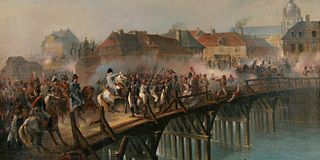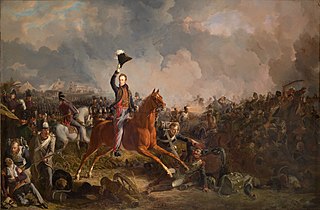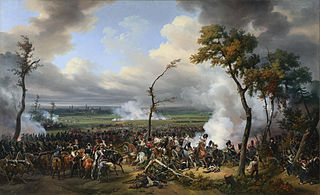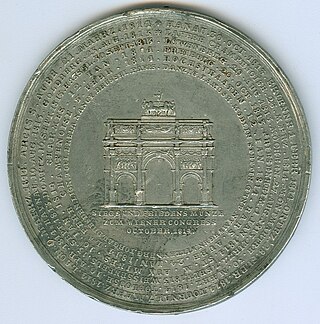Battle
Ferdinand's army arrived on the field of battle piecemeal. Ferdinand himself accompanied the vanguard, commanded by the Erbprinz. As Ferdinand mistakenly believed that the French had not yet fully deployed, he ordered an immediate attack, choosing not to wait for the other two divisions.
Despite the long odds, by eight o'clock the town of Vilbel had been seized by Wilhelm von Freytag's light infantry and the "Am Hohen Stein," another low hill located east of the "Berger-Warte," had been occupied. Perceiving that Bergen was the key to the position, by 8:30 Ferdinand had ordered an assault on this position. The initial allied attack was successful, driving the French infantry from the hedges and orchards that they occupied and back into the town. Then Broglie began to feed in reinforcements which turned the tide against the allies, driving them back.
At ten o'clock Prince Isenburg's division arrived. Isenburg pitched into the fray, once again driving the French troops back into Bergen. Broglie immediately counterattacked with more fresh regiments that he had fed in from his reserve, disordering the allies and driving them back once more. Isenburg himself was killed while trying to rally his men. It was with difficulty that Ferdinand himself was able to restore order to his troops.
At this point, the battle began to cool off. As Broglie brought his reserve and his cavalry forward, Ferdinand was able to gauge the size of his opponent's army. Furthermore, the French artillery was finding its range and forcing the allied army back up the "Am Hohen Stein." As Holstein-Gottorp's division finally made it onto the field, preparations for another attack were abandoned and the battle turned into an artillery duel that lasted until the fall of night, when the allies withdrew. Although it was a clear French victory, Broglie did not aggressively pursue Ferdinand, who was able to slip away with his army back toward Minden.

The Battle of Leipzig, also known as the Battle of the Nations, was fought from 16 to 19 October 1813 at Leipzig, Saxony. The Coalition armies of Austria, Prussia, Sweden, and Russia, led by Tsar Alexander I and Karl von Schwarzenberg, decisively defeated the Grande Armée of French Emperor Napoleon Bonaparte. Napoleon's army also contained Polish and Italian troops, as well as Germans from the Confederation of the Rhine. The battle was the culmination of the German Campaign of 1813 and involved 560,000 soldiers, 2,200 artillery pieces, the expenditure of 400,000 rounds of artillery ammunition, and 133,000 casualties, making it the largest battle of the Napoleonic Wars, and the largest battle in Europe prior to World War I.

The Battle of Arcis-sur-Aube saw an Imperial French army under Napoleon face a much larger Allied army led by Karl Philipp, Prince of Schwarzenberg during the War of the Sixth Coalition. On the second day of fighting, Emperor Napoleon suddenly realized he was massively outnumbered, and immediately ordered a masked retreat. By the time the Austrian Field Marshal Schwarzenberg realized Napoleon was retreating, most of the French had already disengaged and the Allied pursuit afterwards failed to prevent the remaining French army from safely withdrawing to the north. This was Napoleon's penultimate battle before his abdication and exile to Elba, the last being the Battle of Saint-Dizier.

Victor François de Broglie, Duke of Broglie was a French aristocrat and soldier and a marshal of France. He served with his father, François-Marie, 1st duc de Broglie, at Parma and Guastalla, and in 1734 obtained a colonelcy.

The Battle of Rossbach took place on 5 November 1757 during the Third Silesian War near the village of Rossbach (Roßbach), in the Electorate of Saxony. It is sometimes called the Battle of, or at, Reichardtswerben, after a different nearby town. In this 90-minute battle, Frederick the Great, king of Prussia, defeated an Allied army composed of French forces augmented by a contingent of the Reichsarmee of the Holy Roman Empire. The French and Imperial army included 41,110 men, opposing a considerably smaller Prussian force of 22,000. Despite overwhelming odds, Frederick managed to defeat the Imperials and the French.

The Battle of Oudenarde, also known as the Battle of Oudenaarde, was a major engagement of the War of the Spanish Succession, pitting a Grand Alliance force consisting of eighty thousand men under the command of the Duke of Marlborough and Prince Eugene of Savoy against a French force of eighty-five thousand men under the command of the Duc de Bourgogne and the Duc de Vendôme, the battle resulting in a great victory for the Grand Alliance. The battle was fought near the city of Oudenaarde, at the time part of the Spanish Netherlands, on 11 July 1708. With this victory, the Grand Alliance ensured the fall of various French territories, giving them a significant strategic and tactical advantage during this stage of the war. The battle was fought in the later years of the war, a conflict that had come about as a result of English, Dutch and Habsburg apprehension at the possibility of a Bourbon succeeding the deceased King of Spain, Charles II, and combining their two nations and empires into one.

The Battle of Minden was a major engagement during the Seven Years' War, fought on 1 August 1759. An Anglo-German army under the overall command of Prussian Field Marshal Ferdinand of Brunswick defeated a French army commanded by Marshal of France, Marquis de Contades. Two years previously, the French had launched a successful invasion of Hanover and attempted to impose an unpopular treaty of peace upon the allied nations of Britain, Hanover and Prussia. After a Prussian victory at Rossbach, and under pressure from Frederick the Great and William Pitt, King George II disavowed the treaty. In 1758, the allies launched a counter-offensive against the French and Saxon forces and drove them back across the Rhine.

The Battle of Quatre Bras was fought on 16 June 1815, as a preliminary engagement to the decisive Battle of Waterloo that occurred two days later. The battle took place near the strategic crossroads of Quatre Bras and was contested between elements of the Duke of Wellington's Anglo-allied army and the left wing of Napoleon Bonaparte's French Armée du Nord under Marshal Michel Ney. The battle was a tactical victory for Wellington, but because Ney prevented him going to the aid of Blucher's Prussians who were fighting a larger French army under the command of Napoleon Bonaparte at Ligny it was a strategic victory for the French.

The Battle of Hanau was fought from 30 to 31 October 1813 between Karl Philipp von Wrede's Austro-Bavarian corps and Napoleon's retreating French during the War of the Sixth Coalition.

The Battle of Laon was the victory of Blücher's Prussian army over Napoleon's French army near Laon. During the Battle of Craonne on 7 March, Blücher's army was forced to retreat into Laon after a failed attempt to halt Napoleon's east flank. Along the way to Laon, reinforcements from Russian forces under Ferdinand von Wintzingerode and a Prussian corps led by Friedrich Wilhelm Freiherr von Bülow joined the defensive. Blücher opted to face Napoleon at Laon because it was the site of a strategically important road junction, and because of its highly defensible position.

The Battle of Lauffeld, variously known as Lafelt, Laffeld, Lawfeld, Lawfeldt, Maastricht, or Val, took place on 2 July 1747, between Tongeren in modern Belgium, and the Dutch city of Maastricht. Part of the War of the Austrian Succession, a French army of 80,000 under Marshal Saxe defeated a Pragmatic Army of 120,000, led by the Duke of Cumberland.

Ferdinand, Prince of Brunswick-Lüneburg, was a German-Prussian field marshal (1758–1766) known for his participation in the Seven Years' War. From 1757 to 1762 he led an Anglo-German army in Western Germany which successfully repelled French attempts to occupy Hanover.

The Battle of Kloster Kampen was a tactical French victory over a British and allied army in the Seven Years' War. The Allied forces were driven from the field.

The Battle of Guastalla or Battle of Luzzara was a battle fought on 19 September 1734 between Franco-Sardinian and Austrian (Habsburg) troops as part of the War of the Polish Succession.

The Battle of Corbach, or Korbach, a Hanseatic town of Waldeck-Frankenberg in northern Hesse, Germany, was fought on 10 July 1760 during the Seven Years' War. Corbach was the first battle of the campaign of 1760 and was a victory for the French over the Hanoverians, the British and their allies.

The Second Battle of Wissembourg from 26 December 1793 to 29 December 1793 saw an army of the First French Republic under General Lazare Hoche fight a series of clashes against an army of Austrians, Prussians, Bavarians, and Hessians led by General Dagobert Sigmund von Wurmser. There were significant actions at Wœrth on 22 December and Geisberg on 26 and 27 December. In the end, the French forced their opponents to withdraw to the east bank of the Rhine River. The action occurred during the War of the First Coalition phase of the French Revolutionary Wars.

The siege of Bergen op Zoom took place during the Austrian War of Succession, when a French army, under the command of Count Löwendal and the overall direction of Marshal Maurice de Saxe, laid siege and captured the strategic Dutch border fortress of Bergen op Zoom on the border of Brabant and Zeeland in 1747. The fortress was defended by Dutch, Austrians, British, Hanoverians and Hessians that supported the Pragmatic Sanction.

AugustFriedrich von Spörcken (1698–1776) was a Hanoverian soldier best known for his service in the Seven Years' War. He served as part of the Army of Observation between 1757–1762 leading the Hanoverian contingent at a number of major battles including Krefeld and Minden.
The Rt. Hon. George Charles, Baron de Dyhern, was a Saxon general, war minister under the regency of Augustus III. of Saxony, king of Poland and a close friend of Field Marshal Count Frederick Augustus Rutowsky.

The Battle of Hoogstraten was fought on 11 January 1814 between a French army, led by François Roguet, and a Russo-Prussian-British army, led by Friedrich Wilhelm Freiherr von Bülow. The battle, which ended in a Prussian victory, consisted of a series of engagements situated between Essen and Turnhout. The battle was named after Hoogstraten, the main town of the Kempen region.

The Battle of Saint-Julien saw Imperial French troops led by Jean Gabriel Marchand attack Austrian soldiers under Johann Nepomuk von Klebelsberg. In tough fighting, the Austrians managed to hold off persistent French assaults during this War of the Sixth Coalition clash. The next day, the Austrians withdrew within the defenses of Geneva, a distance of 9 kilometres (6 mi) to the northeast. The battle was part of operations in which a French army led by Marshal Pierre Augereau squared off against Austrian forces under Ferdinand, Graf Bubna von Littitz.



















